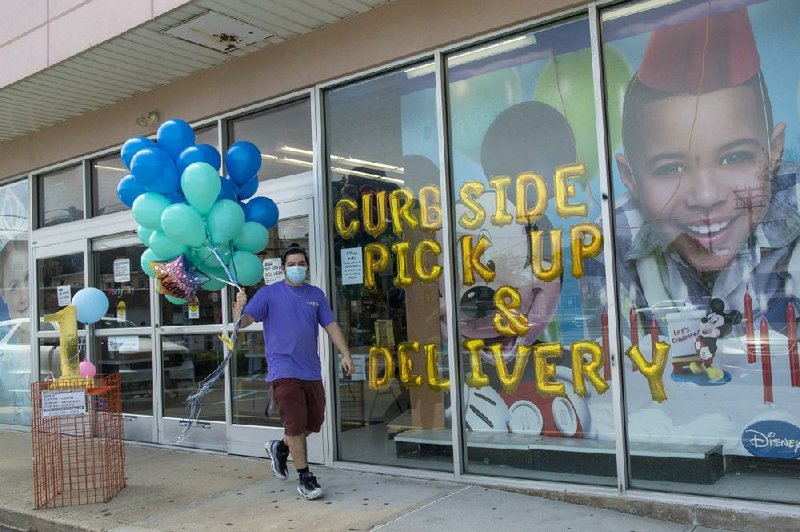WASHINGTON -- Roughly 2.1 million people applied for U.S. unemployment benefits last week, a sign that companies are still slashing jobs in the face of a deep recession even as more businesses reopen and rehire some laid-off employees.
About 41 million people have now applied for aid since the virus outbreak intensified in March, though not all of them are still unemployed.
Continuing claims, which tally Americans' ongoing benefit claims in state programs, fell from 24.9 million to 21.1 million for the week ended May 16, Labor Department figures showed Thursday. Those data are reported with a one-week lag. That suggests the job market is starting to rebound as businesses reopen. Analysts had expected an increase in continuing claims.
Continuing claims data serve as a rough measure of the number of unemployed Americans.
[CORONAVIRUS: Click here for our complete coverage » arkansasonline.com/coronavirus]
The national jobless rate was 14.7% in April, the highest since the Great Depression, when it peaked at an estimated 25.6%. Next week's May jobs report is forecast to show an unemployment rate of around 20%.
While the latest initial-claims tally was down from the previous week's 2.45 million and marked the eighth straight weekly decline, it's still far above the 212,000 average of initial claims in the first two months of 2020 and the pre-pandemic record of 695,000. California, New York, Florida and Georgia had the highest initial claims last week.
Pantheon Macroeconomics chief economist Ian Shepherdson flagged one caveat with the continuing claims numbers: While "gross hiring is beginning to rebound," the figure "overstates the true extent of the hiring," given that California -- where residents file every other week -- posted a 1.4 million unadjusted decline, Shepherdson said in note. Florida also showed a drop of 1.6 million.
Thursday's report also showed that filings under the separate, federal Pandemic Unemployment Assistance program -- which expands unemployment benefits to those not traditionally eligible, such the self-employed and gig workers -- fell to 1.19 million from 1.25 million on an unadjusted basis, covering 32 states. The previous week's figure was revised lower by about 1 million because of an error by Massachusetts.
In recent weeks, many states have started lifting restrictions imposed in March meant to limit the spread of the coronavirus, which by Wednesday, had killed more than 100,000 across the country. But the recovery process has been uneven, hamstringing some states and employers more than others. In a number of states, a very large segment of the labor force is now collecting unemployment benefits. For example, 26.7% of the labor force in Nevada is collecting unemployment benefits, as are 25% in Florida. Even 20.6% of the labor force in California -- the U.S.'s most populous state -- is collecting jobless claims.
Analysts are monitoring incoming economic data to gauge how consumers are responding as many retail establishments gradually reopen. Jobs won't return in any significant way as long as Americans remain slow to resume spending at their previous levels.
Data from Chase Bank credit and debit cards shows that consumers have slowly increased their spending since the government distributed stimulus checks in mid-April. Consumer spending had plunged 40% in March compared with a year earlier but has since rebounded to 20% below year-ago levels.
Most of that increase has occurred in online shopping, which has recovered to pre-virus levels after having tumbled about 20%. But offline spending, which makes up the vast majority of consumer spending, is still down 35% from a year ago, according to Chase, after having plummeted 50% at its lowest point.
Since March, Americans unexpectedly out of work have benefited from an additional $600-per-week in unemployment aid, a historic enhancement to jobless benefits authorized under the $2 trillion Cares Act.
But the aid is set to expire at the end of July without further congressional action, which Trump and his GOP allies have opposed. The potential loss of that critical cash -- leaving some Americans with much smaller unemployment checks -- may send some workers scrambling this summer to try to find new gigs in a dour market.
Those who aspire to return to the workforce, seeking new positions amid a battered economy, are likely to find their options limited and less than ideal. Already, some economists said they had noticed a growing reluctance on the part of workers to apply for positions where face-to-face interaction is required -- and working at home might be difficult or impossible.
Information for this article was contributed by Christopher Rugaber of The Associated Press, Katia Dmitrieva of Bloomberg News and by Tony Romm of The Washington Post.
Business on 05/29/2020
